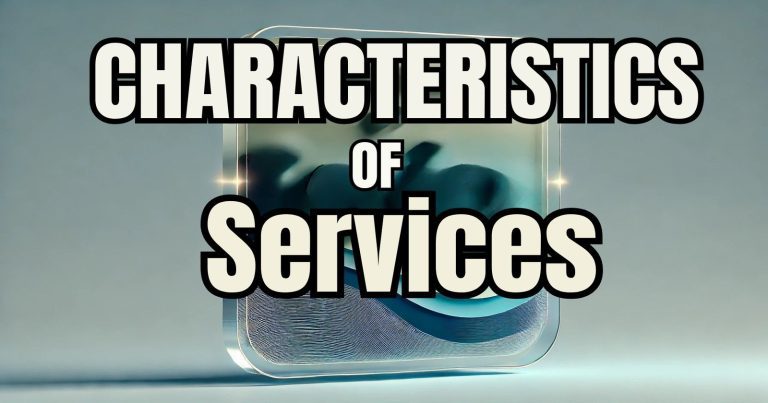Services are intangible, immaterial economic activities or rewards offered by one party to the other. Characteristics of service is a very important concept in the service industry as it influences the delivery, marketing, and consumption of these offerings. Services cannot be physically seen, and no human can feel their touch; however, their worth is incredibly immense, and they occupy the foremost place in the entire economies of the world. The following article explains the nature of services, the significance of their contribution to the service sector, and some illustrations depicting this character.
Definition of Service
A service is any activity or service offered to fulfill a want by a customer. A service is intangible, cannot be separated from its origin, and is perishable. It is characterized by conferring utility or satisfaction but not by owning something tangible. The lion’s share of the core aspects of modern economies falls in the service sector of banking, health care, education, and hospitality. The value content of such sectors is experience-based and very highly personalized; it emanates from action rather than tangible goods.
Unique Characteristics of Services
Services are intangible activities or benefits provided to satisfy customer needs without resulting in ownership of a tangible product. The characteristics of services—intangibility, inseparability, perishability, variability, and lack of ownership—set them apart from goods. These traits influence their delivery, marketing, and consumption across industries. The characteristics of service industry are as follows:-
Intangibility
Intangibility refers to services being non-physical and cannot be touched, seen, or stored. Their review often depends on the perception of customers and their experiences. Thus, trust and reputation are vital for service providers. To overcome this, many service providers use testimonials, reviews, and guarantees to assuage consumer confidence. Examples of Intangibility are:-
- The worth of a therapy session lies in the emotional reprieve afforded and not the commodity given.
- An advisor’s excellence is determined by how lucid and useful the advice they dispense.
Inseparability
Services require the simultaneous involvement of the service provider and the consumer for generation and use. Therefore, interactive involvement is essentially a necessity in services and it calls for a professional who would manage relationships effectively. This direct interaction places great emphasis on the experience of the customer. Examples of InseparabilityDentistst with the patient are required to be physically present for the provision of a service.
- A dance teacher has to be with her students to effectively teach choreography.
Perishability
Services are perishable in that they cannot be stored, saved, or resold for later use. Unused services are a lost opportunity, and thus, businesses must schedule them efficiently and forecast demand to minimize waste. Businesses often use dynamic pricing to consume during off-peak times. Examples of Perishability are:-
- A theater seat left vacant for a showing of a film means lost money.
- Hotel rooms can’t be sold if not booked for an overnight stay once the day has ended.
Volatility
Services are variable in the person offering, location, and context. Only with sufficient training, process standardization, and mechanisms for getting customer feedback will consistency in high-quality service be assured. The potential for personalization opportunities, however, can convert variability into a source of competitive advantage. Examples of Variability
- A waiter’s attitude and demeanor may determine the experience a diner has in a restaurant.
- The same tour can be a very interesting subject for the tourist when handled by an interested tourist guide.
Lack of Ownership
Services benefit or add value without transferring ownership of a physical entity. The consumer only gets to use the service for the period of the transaction. This gives businesses the chance to focus on improving the experience rather than selling a product. Examples of Lack of Ownership are:-
- A hired car gives the customer temporary use without transferring ownership of the vehicle.
- Netflix is a streaming service that allows people to access content without owning it permanently.
Customer Involvement
The participation of the customer in the delivery of service makes a lot of difference in the outcome. Attitude, cooperation, and involvement on the part of the customer can add quality or reduce it in the experience of service delivery. Providers of service often instruct their customers to achieve optimal participation. Examples of Customer Participation are:-
- For the teacher of a yoga class to be effective, the student has to be an active participant in the exercise.
- For instance, at a self-serve buffet, the consumer is actively selecting and serving her/his meal.
Heterogeneity
Because the delivery of services is bound to depend on providers’ skills, customer preferences, and situational context, services are always heterogeneous in their delivery. It is difficult for providers to achieve homogeneity; they apply heterogeneity that allows them to reach various customers in a manner ofsatisfiesg them so that they would be loyal. Examples of Heterogeneity are:-
- A private tutor can teach the same subject differently according to the student’s learning pace and learning style.
- Customer support teams usually handle similar issues differently based on the approach of the respective agents.
Simultaneous Production and Delivery
Services do not involve any separation between their creation and consumption. This quality rules out the possibility of inventory but leaves the scope for real-time feedback and adjustments in delivery. Examples of Simultaneous Production and Delivery are:-
- A live concert is produced and consumed simultaneously by the audience.
- A masseuse provides relaxation in real-time, as the service cannot be prepared or delivered beforehand.
Personalization
Personalization enables businesses to customize their services according to the specific preferences of their customers. This attribute makes services more attractive and creates long-term relationships through customer satisfaction and loyalty. Examples of Personalization are:-
- A luxury hotel may remember and provide a welcome guest’s favorite room temperature and pillow material.
- An e-retailer makes recommendations for products that a user has browsed or purchased in the past.
Non-Transferability
The services are consumed by the owner or the beneficiary, and cannot be transferred to another. This is a characteristic underlining exclusivity and personalization that is inherent in services. Examples of Non-Transferability are:-
- A ticket for a music concert is non-transferable, as it is tied to the identity of the purchaser.
- A gym membership is individual and cannot be transferred to someone else without re-registration.
Importance of Services in the World Economy
Service sectors of most countries, especially the developed ones, account for a significant share of the GDPs. This includes employment, innovation, and the quality of life.
- Percentage Contribution to GDP: Service intangibility and customer interaction make the sector an integral part of consumer satisfaction-driven economies. Services industries currently contribute to nearly 65% of the world’s GDP in 2021.
- Job Generation: Service industries are labor-intensive. The healthcare and education sectors are among the leading employment opportunities for skilled and semi-skilled employees around the world.
- Driver of Innovation: Services aid innovation through consumer voice and participation in real action. For example, fintech innovation technology explains how services are made to meet the consumer’s needs.
Characteristics of Services with Examples
Examples from various industries are given in detail, which gives a better idea about the characteristics of services. Each characteristic of service sector explains how services can be delivered and received, hence examples are also required to make them more viable in practice.
Intangibility
Services are intangible experiences or benefits, which cannot be physically touched or owned.
Example 1: An investment counselor advises the client on where to invest his money. Here, the customer pays for expertise and advice instead of a product.
Example 2: An entertainer, in this case a concert, performs. The viewer pays for an experience, not a tangible outcome.
Inseparability
Production and consumption of services go hand in hand. Generally speaking, the time of service provision is the same time at which the provider and customer are in the same location.
Example 1: A haircut requires the concurrent presence of both the barber and the client at the salon.
Example 2: A patient and a counselor interact in real time during a counseling session for mutual interaction.
Perishability
Services can never be stockpiled for later or inventoried.
Example 1: An unreserved hotel room overnight is lost as it cannot be sold again on that date.
Example 2: Seats in a theatre for a specific show time get wasted if it is not availed during that time frame.
Variability
The service quality may vary with who serves when they serve, and under what circumstances.
Example 1: Two waiters of the same restaurant can offer different levels of service, which therefore affects the customer’s satisfaction.
Example 2: This is an experience in a taxi ride that varies with the character of the driver, the car condition, and the traffic condition.
Lack of Ownership
Services give access or benefits but don’t give ownership of any tangible goods.
Example 1: Car rental provides the customer with temporary permission to use an automobile as a means of transportation but never allows ownership rights.
Example 2: Subscription to a video streaming site provides viewing access to the video content but does not provide ownership rights to the said video content.
Characteristics Of Sercives FAQs
What are some characteristics of service characteristics?
The key features of services include intangibility, inseparability, perishability, variability, and intangibility.
What are the services’ special characteristics?
Services are characterized by special features, like intangibility and perishability, which make them different from goods. Services can only be delivered in real-time and have no inventory or ownership.
Why is knowledge of service characteristics important?
This is because it will help businesses design better experiences for their customers and better manage variability and perishability among others.
What are examples of characteristics of the service sector?
The characteristics include customer contact in hospitality, real-time delivery in healthcare, and personalization in education.
How is the service sector influencing the economy?
Gross Domestic Product is driven by the services sector, new employment generation, and innovation in these economies.


